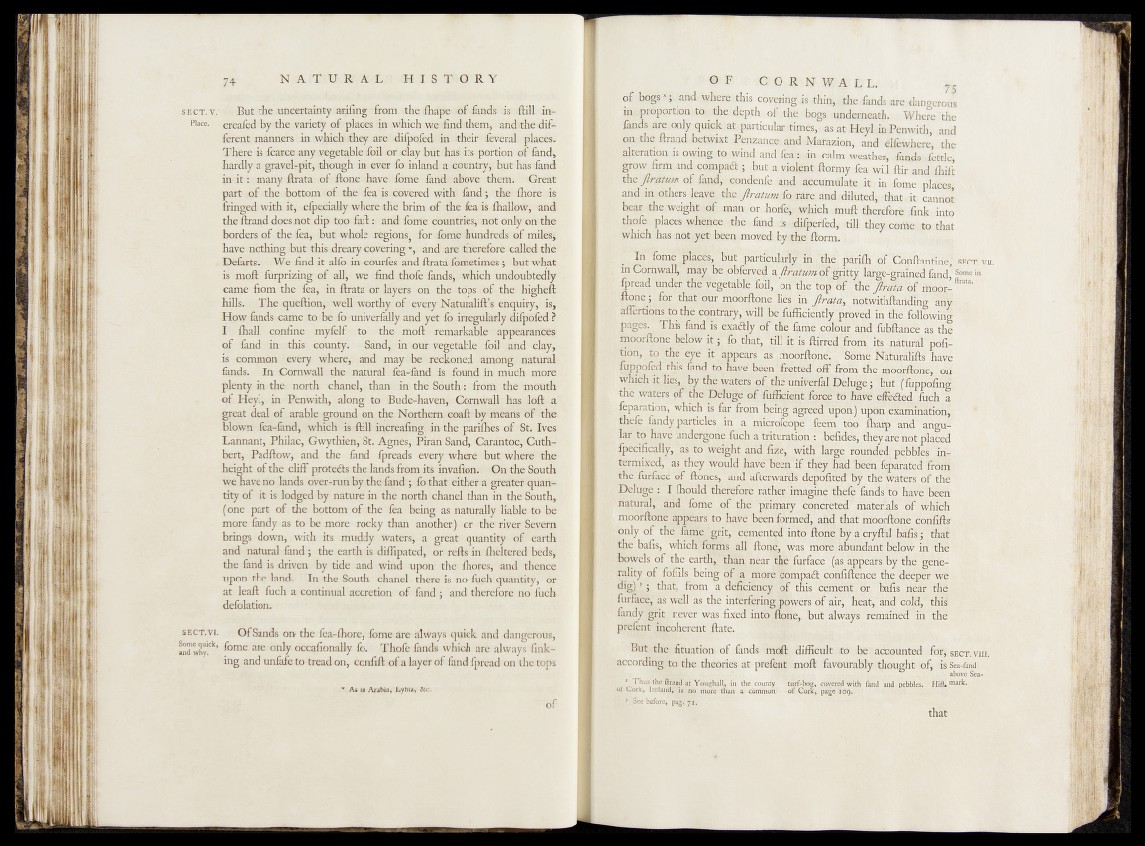
74 N A ï U R A L I ' H I S T O R Y
« -But' . th© uncertainty ar ifing from. the A f ibfiife '-is 'ifijfl in-
,i:.Place. creafeddiyft-he variety of plases ^ .BKhicb wesfindsthem,. anditfee different
manners in ,w;bkb They aace difppfed in itheir ifeveral places;
There is fcaxee any vegetable foil .or ;day:bat has its portion of land,
hardly a gravelrpit, though in ever lb inland 4 .country, hut has fond
in i t ; m^ny jftrata i£>f ilone have! fome fond; atove them. Great
part ,of the bottom o f .the fea kietsKered with: fond; the^Thore is
fringed with it, efpedAy where ;the’ brim of the lea is Shallow, and
the ftranddoesnot dip tq© faft: and Ibme countries, not only ©n th©
horders-of idle- fea, hut whole regions, i$qr feme hundreds o f mile%
have nothing but this dreary .covering *, and are therefore called the
1 Deforts. We find it alfo in gquA s and fbafo foaetimes 5 but what
is moft lurprizing of A , we find thofe lands, which undoubtedly
came from the fea, in ftrata or layefs on the tops - o f the. higheft
hills. The queftfon, well worthy of every Naturalift’s enquiry,; is,
How fonds came to be fo univerfally and yet fo irregularly difpbfed ?
I fib A confine myfelf to the moft remarkable appearances
o f fond in this county. Sand,, in our vegetable and-(day,
is common every where, and may be reckoned among natural
fonds. In ComwA the natural lea-fond is found in much more
plenty in the north chanel, than in the South : from the mouth
of Heyl, in Penwith, along to Bude-haven, Cornwall has loft a1
great deal ©f arable grqund on the Northern, eoaft by-inCans of the
blown fea-fond, which; is ftilf iqcreafing. in the parifhes of St, Ives.
Lannant, Philac, Gwythien, St. Agnes, PiranSand, Gafantoc,: Ctith-
bprt, Padftow, and the fond fpreads every w h ^ dsmt wbdr© the
height of the cliff protects the lands from its invafion. On the South
wehaveno lands over-run by the fond ; fothat either a gfeaifef quantity
o f it is lodged by nature in the north - chanel than in the South,
(one part of the bottom o f the fea being as naturally liable-to t e
mare fondy as to be more roeky than another ) or the river Severn
brings down, with its muddy waters,-a great quantity of earth
and natural fond; the earth is diffipated, or refts in fheltered beds,
the fond is driven by tide and wind upon: the fhofes, and thence
upon the land. In the South chanel there is no fooh quantity, or
at leaft fuch a continual accretion of fond j and therefore no fuch
defolation.
s e c t . vi. O f Sands on the fea=-£hore, fbme are always quick and dangerous,
andwhy!ck’ f°me are only occafionally. fo. Thofe fonds which are always finking
and unfofeto tread on, confift of a layer of fond fpread on the tops
© F ' V.fj&O R i f W J L L L . H
of bogs*; and where this covering is thin, the fonds are dangerous
in proportion to the depth of the bogs underneath. Where the
fonds. are only quick at particular times, as at Heyl in Penwith, and
on the ftrand betwixt Penzance and Marazion, and elfewhere, the
alteration is owing to wind and fea: in calm weather,, fands .fettle,
a ftormy^feg. wilfftir and. fhift
jlr^Upm of fondyh^pdenfe. foqd.4ajpcumAafe.it .fe-feme pikesj
and fojtt&hers lea^ .the and/diluted,uthat, it cannot
bear it?he weigh&3©f .man or horfefc«vhieh muft therefore fink into
thofeteplaces whence,'the land is difperfed, till they confe .to that
which' has ncfo yet. been moved by;the-ftorm.
ïn^Tome’^ è l , but |artiGula®® Jjhe, panlÉbf/CqnftanïïniEcr. vn.
' fond/ Soit>ei" :■
fpread under e top o f "the ftrMa%o f iJmor- ^
° ^ fu ° ar^°ne liesi in, èrfital^ nbtwifhilariclmg any
affertions to the contrary, willjbejfiifficiehtiy proved in“fbe Tóllbvs|S^
the. fame 8
fnoorftone below it jT o that, till it is‘ftirrecl ^rom^^nathrff1 pofi-
fion, to "the eye it' appears as j'ihqbrftqn4 ' ? ^ t o q ^almraliis Jave
fuppofed this fond td have been fretted off* from the moorfiohe, . orf-
which it lies, by the Watersvpf the univerfol Deluge ; | hut ffeppofing
the waters pf the. Deluge of fufficient force to ha^e effected fifeh fo
feparation, which is far from being agreequpcMfupc^.examnation^
B h | reticles 9
Iar to have undergone fuch a trituration\'\heri&s,. tfoey are pptblaced
fpecifically/fos ïo'Veight and fize,f with lar^Tduride^hebbles' Yrfo
termixed, as they would have“been if they had been feparated from
the furface of ftones, and ffterwards depofited by tkp w^terl{JQf tSI
Deluge; : I fhould therefore rather'imagine' tfrele fands fo^h^e'beeïi
natural, and fbme o f the priipa.ry concreted' materials of which
moórftorte appears to have been formed, aiid that mborftone confifts
|AiIy of the lame 'grit, cemented into ftohe. by a cryfïakbafi^f
the bAs, which fbrrtis A fton^ was m^^lÉaqdant^ Öelow in^éil*
bowels of the earth, than near the furface (as^appears’ by^fhe generality
of foflils being of a morq sompadt confift|nce the foeepaj ^ve
dig).y) that, from a deflciency of this cemenfror bafis near the
furface, as well as the interfering powers o f air, heat, and colHfthis
fondy gri|| never was fixed into frone, but alwkjls foemainecPin the
prefent incoherent ftate.
But the fituation of fonds möft' difficult to bfe'J accounted for^sECT.vAl
according^to the theories at prefent moft favourably ^bought'of, is Sea-rand I
Sea- ,
at Youghall, in the co.unty turf-bog, covered with fand and pebbles. ' Hift9 mark. ^
w Görkj Ireland, is no more than a common: of Cork, page T09.
f f lp gee before, pag;? 71. -
that